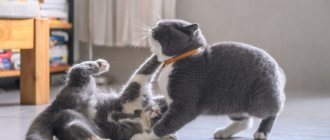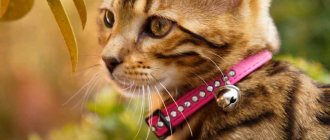If you are a cat owner or simply want to understand cat behavior, one question you may have is why do cats hiss? Most cat owners will attest to the fact that their furry friends sometimes display very unpredictable behavior; one moment you're having a good time, and the next you're caressing a scratch on your arm. Another common behavior is hissing. This is a snake-like voice that felines make to kittens, people, inanimate objects, and even other cats.
Cats have adapted to living indoors or near the house; this is due to certain difficulties that they have to overcome. Socializing with people and other pets is important to them, and vocalization, which can come in the form of hissing, is high on the list. Hissing is not only a sign of aggression; it can communicate different things.
To better understand hissing in cats, we'll start by looking at how the sound is made. We'll also look at eight different reasons why cats feel the need to hiss. Read on to find out more about this strange cat behavior.
"Hises like a snake"
Hissing is a very specific sound, eloquently indicating a strong negative reaction. A surge of irritation and negative emotions confirms the entire appearance of the animal:
- open mouth with demonstration of the entire combat set of teeth;
- burning eyes with dilated pupils;
- ears pressed to the head;
- an angry bristling mustache;
- raised wool.
Associated reactions. Depending on the degree of threat and personal temperament, the severity of the defensive reaction is not always the same, so a hissing cat may:
- At the next moment, quickly retreat, fleeing.
- Take a characteristic pose with an arched back and fluffy tail raised up, which means a more serious attitude and an attempt to intimidate the enemy.
- Apply several blows with a clawed paw, while grouping yourself and pressing your stomach to the ground, which symbolizes the intention to fight. The tail twitches nervously or whips from side to side.
Who is guilty. Dissatisfaction, fear and aggression, encrypted in hissing, can be directed both at a specific living object (a rival cat, a dog, a stranger) and “into space”, being initiated by a sudden loud sound or a flashing shadow. Regardless of the source, the cat's expression of displeasure, when further provoked, can develop into an attempt at violent self-defense and end in a harsh aggressive attack.
Why does a pet suddenly become aggressive and attack its owners?
Most often, aggressive behavior is not a pathological deviation, but a consequence of the emotional state of the animal
It is necessary not only to pay attention to the immediate circumstances that led to the manifestation of hostility, but also to look for reasons in the environment, in previous events, in the cat’s past. Patient observation of your pet will help you find triggers and take measures to eliminate them.
Reaction to pain and ill health
Pain is the most common cause of sudden aggression, especially in older or restless cats. Arthritis, dental disease, injury or infection are just some of the reasons that can cause aggressive behavior. In this case, the attack occurs not only after touching, but also when the suffering pet tries to prevent possible painful contact.
Other physiological conditions also lead to aggression. Cognitive decline, loss of normal sensory perception (hearing, vision, smell) or neurological problems distort instinctive mechanisms for recognizing danger.
Sudden fear or prolonged stress
Aggression can occur in a situation where the cat feels threatened or trapped. The fight-or-flight reflex involves the sympathetic nervous system: if there is nowhere to run, the only option is to fight. Having instantly mobilized all its physical capabilities, the cat rushes to attack, and therefore such cases are especially dangerous.
Long-term stress in cats is caused by both excessive attention and neglect on the part of the owner or mistress. Not all representatives of this genus can tolerate endless affection and contact with people
“Loved” pets are in a state of stress and can react with spontaneous hostility to violation of their personal space. Parting with the owner or limiting contact with him can also provoke outbursts of rage, the purpose of which is to attract attention to oneself.
Unpleasant changes: a new smell, rearrangement of furniture, appearance of a competitor
Adaptation to new conditions is another stress factor for a cat. The aggression that arises in connection with this is called status aggression. It may arise if the owner decides to move the pet to another room, change the feeding place, or introduce new rules of the hostel. Jealousy towards other pets can also cause sudden outbursts.
Redirected aggression occurs when a cat is scared or upset, but instead of going after the true object of concern, it turns its anger towards an easy target. To relieve excitement from an external and inaccessible stimulus - unpleasant noise, smell, game, competitors, she rushes at any person nearby.
Fight for freedom, food and territory
A pronounced sense of ownership is found in both females and males. This type of behavior, unlike normal and temporary maternal aggression, can create problems. The target of an attack can be not only animals or unfamiliar visitors, but also the owners themselves. For example, it is often said that a mustachioed villain attacked one of the family members after he was forced to sit behind a closed door. There are cases when an irritated pet deliberately bites its owner, who is trying to intervene in his conflict with competitors.
Many cats, deprived of human contact at an early age, perceive their presence as a threat and use their claws and teeth to put the “enemy” to flight. While on its territory, the unsociable predator bites and scratches the alien and calms down only after it manages to drive him away.
Hissing as an expression of fear and displeasure
Fear, as you know, is the most important incentive to action.
A sense of security is a cat’s most important need, and the instinct of self-preservation is the basis of survival.
A person can cause fear and fear if the cat:
- Wild and uncommunicative. In this case, the animal does not allow any people to approach itself, does not understand their intentions and does not accept human affection in principle.
- Has negative communication experiences. Unpleasant, scary and painful events from the past can leave an imprint on the current state of the animal. Sometimes a cat demonstrates associative fear and, for example, may hiss at children if it has once encountered their cruelty. Cats also remember a specific offender, expressing persistent negativity towards the person who once insulted “their tailed majesty.” Such a source of unpleasant sensations often becomes a veterinarian who gives injections to a sick animal, measures rectal temperature and performs other very unpleasant actions.
- She is not socialized and has spent her entire life communicating only with a limited circle of people. If an animal is used to living in peace and quiet, communicating only with its owner and his family, then perhaps he will be frightened by a noisy company of guests or a repair team coming to the house.
Pet behavior. Usually a frightened cat tries to run away and hide, but if, after a warning hiss, they block its path to retreat, try to touch it or pick it up, the instinct of active self-defense will kick in. Sometimes a cat hisses at its owner, frightened by a sharp gesture, sound or object in its hands. Aggressive and poorly behaved pets may react with a hiss to the lack of a desired action, for example, when the owner does not give them food or a portion of affection upon request.
Aggression
Cats are brave animals and thus demonstrate that, despite fear, they are ready to defend themselves. Such actions can also be caused by sudden movements of the owner, which the pet regards as aggression.
You can assess your pet’s condition by its appearance: it becomes tense, arches its back to appear larger, flattens its ears, and its pupils constrict. This appearance is characterized by a sharp surge of adrenaline and high concentration. The tousled fur gives the animal an intimidating appearance.
Do not punish your pet under any circumstances; after a while he will calm down and most likely come up to you and ask for affection. Try not to make sudden movements near the animal so that such situations do not arise.
Hissing when defending territory
It is known that cats have a reputation for being loners and individual owners, putting their independence above all else. The tamed animal considers the master's house to be its territory and is ready to zealously defend it from the invasion of strangers. It is noteworthy that competitors in the struggle for possessions may become:
- tribal cats;
- dogs and other pets;
- newcomers;
- owner and his family.
Zoo aggression is especially pronounced against the four-legged intruder.
This is why adult cats have great difficulty getting used to their newly arrived relatives. In this case, the hissing, demonstration of aggression and fights will continue until one of the rivals admits defeat, taking a subordinate place in the “pride” hierarchy.
Sharing territory with a person. Sometimes the dictator cat pours out its possessive instincts on humans. Thus, a tailed aggressor can hiss and swing its paw:
- when trying to take a seat next to you on the sofa or in an armchair;
- driving away from a plate of food;
- guarding toys, scratching posts and other items that he considers his own;
- sitting in a house or in a favorite place.
The smell of another cat, which the owner brought from the street or while visiting, can stimulate territorial aggression.
Main reasons
A cat's hiss is one of the ways to communicate with the outside world. What could this behavior mean:
- protecting the territory that the cat considers his own;
- protection of young;
- aggression;
- fear;
- anxiety;
- pain.
Some cats and kittens constantly hiss due to their aggressive nature and lack of training. This is how animals taken from the street sometimes behave. In addition, certain breeds have a particularly vicious disposition.
Aggression
Often a cat hisses, thus trying to take out anger or resentment on someone. For some reason, the animal cannot or is afraid to show its emotions in front of their source, so it gets to those around them. This is a kind of psychological projection. By the way, people often behave exactly the same way.
Hissing is a natural reaction to stress
An animal can become aggressive not only because of resentment. If the cat has recently had a conflict with one of the pets or street animals, it may take out the remaining aggression. If the shock was too strong, this behavior may persist for several days.
By hissing, the cat primarily wants to scare and drive away the unwanted guest, and not to rush at him. She often hunches over, with her fur standing up from the nape to the tail. Thus, the animal tries to appear larger and more dangerous. If growling and hissing fail, this warning will be followed by an attack. At such moments, it is better not to touch the cat or make sudden movements, so as not to provoke it.
Fact! If the cat has fallen to the floor and growls, most likely he sensed danger in the house or outside it. It's worth being alert.
Stress and depression
Another reason why cats hiss is stress or depression. These feelings may be caused by jealousy if there is a new pet in the house. In addition, cats have a hard time dealing with the death of their brothers with whom they grew up.
Long-term absence of the owner can also cause severe depression. Cats also do not like sudden changes in environment. Moving or renovating, when there are a lot of unfamiliar people and objects in the house, makes animals nervous. The pet hisses when it doesn't feel safe. In this state he will not attack members of the household, but he will not fall into their hands.
Cats have a hard time experiencing loneliness and express their resentment by hissing.
Diseases
During illness, a cat is very vulnerable. Hissing in this case often indicates obvious discomfort. The animal tries to hide and hisses when it feels unwell or when the owner accidentally touches a sore spot. Causes:
- poisoning;
- injury;
- epilepsy;
- failure in the hormonal system;
- toxoplasmosis;
- mental pathologies.
If your cat starts lunging at people and hissing for no apparent reason, you should show her to a doctor.
Territory defense
A cat growls or hisses when someone has encroached on the territory it considers its own. These could be guests, children, other animals. In this situation, sterilization can help, but it cannot be expected to be 100% effective.
An adult cat growls, driving away uninvited guests from her territory, if she has kittens. Thus, she tries to protect them from a potential enemy. If a cat or dog lives in a house with a cat that has recently given birth, it is better to temporarily keep them away from her.
And others
What else causes domestic cats to hiss at people or other animals:
- frustration. This condition occurs when there is no way to satisfy any need. This often happens if a kitten is taken from its mother too early. When such a cat grows up, he will hiss if he is not given something tasty or is not stroked in time. This is not the case when for some reason the pet has not been fed all day, this is a whim and a manifestation of impatience;
- to attract attention. It happens that a cat may start to hiss out of boredom. In this way she wants to attract attention to herself so that she can be played with or stroked;
- Sometimes cats may hiss when mating if this happens on their territory.
Hearing and vision in cats are developed tens of times better than in humans, so the animal can react with a hiss to mice in the basement, small midges, or steps on the floor above. Such developed sensitivity sometimes saves lives.
There are cases in history when a cat saved a person’s life with its strange behavior.
Cats panic, anticipating a fire, earthquake or flood.
Hissing as an expression of dissatisfaction and readiness to attack
The ability to see the reasons for a negative reaction and predict further actions underlies the problem-free coexistence of a person and a freedom-loving cat in the same territory. In order not to aggravate the conflict with the hissing cat, it is strongly recommended not to:
- Imposing your company on the cat and pestering it with food or toys . A pet who is in a bad mood has no time for entertainment, and his appetite at such moments noticeably worsens.
- Try to calm the cat by stroking it . At the moment of inflated feelings, a pet may react inappropriately to an outstretched hand, hitting with a clawed paw and leaving a bloody trail.
- Take the cat in your arms and cuddle it . Most likely, such an attempt will immediately fail, and the angry or frightened cat will become even more furious. Some pets may freeze for a moment in the owner’s hands, but then begin to break free with renewed vigor, dodging and using their teeth and claws.
- Block the animal's escape route . The running cat defiantly asks to be left alone. But if the owner is persistent and begins to chase the animal or tries to detain it, he will certainly cause an outbreak of aggression.
- Trying to get the cat out of hiding. A cat's house is an inviolable personal space, so there should be no intrusion from the outside. An animal huddled in a nook is in a state of stress and seeks salvation in an accessible shelter, and if it tries to bother you, it will most likely launch a serious attack.
Parenting with bites
We use the carrot and stick method when raising our children. A cat does the same thing. But nature gave her much less time for feeding and raising her offspring. Usually after 2-3 months the mother will be ready to bear kittens again, and in such a short period of time she must teach the cubs to survive in the harsh world. Therefore, the cat sometimes uses not only biting kittens, but also hits them with her paw. In this way, the mother tries to instill in the children the rules of conduct, teaches how not to behave. At such moments, she can bite the kitten without causing injury until he understands what is required of him. The cat always makes sure that all children are in her field of vision, in the nest and do not try to leave it. And when her most nimble and curious child shows disobedience, she forces him to obey. Sometimes the mother accustoms her cubs to the tray. And in this case, she also bites them and does not allow them to leave until they do the wet job.
Biting as an educational measure occurs when the cat gets tired, wants to sleep, and children climb on it like on a playground. She calms annoying and nimble children in this way. By the way, if dad lives next to his mother cat, then he can raise his offspring in the same way. This is how daddy cat demonstrates his authority and dominance.
There are always various dangers awaiting kittens on the street. Therefore, the mother is obliged to teach them to fight back the enemy. Even if the cat is domesticated and does not encounter serious predators, at the genetic level the mother is trying to teach her offspring self-defense skills. When she bites children on the neck, she shows them the most vulnerable place in a fight with an opponent - this is how she teaches them to avoid attacks from strangers.
Typically, cat self-defense lessons are played in a playful way. The mother bites the cubs lightly, pinching their skin. The skills acquired from her help the young to survive, defend themselves, their territory, and fight back against the offender.
Hunting instincts
Cats by nature are hunters. They have well developed hunting instincts. A mother can teach her cubs the wisdom of hunting when they are already grown up. She bites them, demonstrating how to capture and hold prey. Sometimes you can see how the mother cat grabs the baby with her front paws, beats him with her hind paws and bites him on the neck. So she teaches him basic hunting skills.
After such lessons, children can hone their skills on each other. And all this happens under the control of the mother. When they play too much, the cat intervenes and bites their neck, letting them know that it’s time to stop.
Cat diseases
Unfortunately, such an effect on the offspring can also be a symptom of the disease. If the cat’s birth was difficult, she is exhausted, then it is difficult for her to control her behavior. She perceives the cubs as irritants. In such cases, the bites are no longer sedative. The cat bites quite aggressively and persistently.
The most common reason for this dangerous behavior of a mother cat is postpartum eclampsia (milk fever). It is the result of a lack of calcium in the body. Its deficiency provokes inappropriate mental behavior of the mother. Sometimes even convulsions occur.
In such situations, there is no way to do without veterinary help. After all, a cat can simply die from depression of the respiratory center. For eclampsia, the doctor administers calcium gluconate intramuscularly. And kittens must be isolated from their mother during the treatment period, otherwise they are at risk of injury.
Hissing when feeling unwell
Pain and physical discomfort are often the cause of irritation in a cat.
The survival instinct dictates that a moping animal should leave everyone, hide in a den and become quiet.
We can conclude that the cat is unhealthy if the hissing is additionally accompanied by:
- refusal of food;
- lethargy and apathy;
- weight loss and tousled hair;
- mucopurulent discharge from the nose and eyes;
- urinary retention and the appearance of blood in the urine;
- drooling, vomiting and stomach upset;
- loss of coordination, unsteadiness of gait and convulsions;
- fever and heavy breathing.
Owner's actions. In cat language, a sick animal asks to be left alone. However, you cannot let the disease take its course and hope for the legendary 9 cat lives. That is why, despite hissing and resistance, the furry pet is urgently transported to a veterinary clinic, where an examination will be carried out and the necessary tests will be done to make a diagnosis and provide qualified assistance.
Hissing as a breed trait
It has been noted that hissing may be a consequence of the breed's temperament. Thus, emotional, easily excitable cats, characterized by a quick and vivid reaction to what is happening, are prone to outbursts of emotions. These are, for example:
- Siamese;
- egyptian Mau,
- Turkish van;
- Abyssinians;
- Cornish Rex;
- orientals.
Living in isolation and lack of regular physical activity does not benefit the character of these cats, making them even more obnoxious and grouchy.
Features of other breeds. Persian and Siberian cats are very jealous of the cleanliness of their “fur coat” and can become angry if you constantly touch them with your hands. In turn, independent British people do not like hugs and cuddles, so they can hiss when treated with familiarity. And sphinxes are prone to sound outpourings and can hiss from an excess of feelings without any negative connotation.
Warns the owner
If a cat lies on its stomach and at the same time hisses, or even growls, then such behavior should not be regarded as aggression at all. Most likely, the animal senses danger and tries to talk about it. If this behavior lasts for a long time, then you need to take a closer look at the pet and take it seriously. Perhaps something hurts, or the pet is stressed.
the cat became aggressive: why and what to do?











